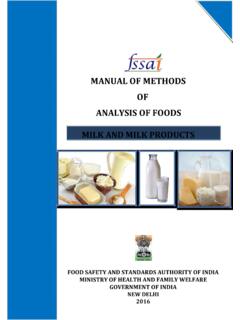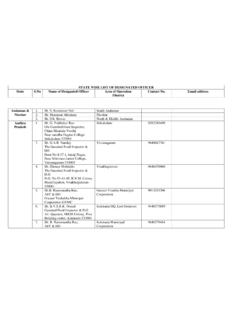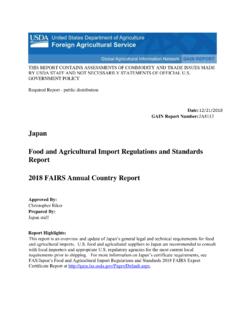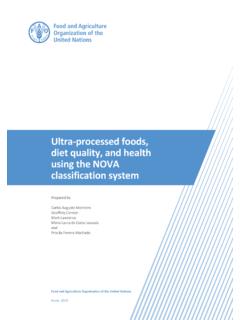Transcription of FOOD ADDITIVES DRAFT - FSSAI
1 LAB. MANUAL 8 MANUAL OF METHODS OF ANALYSIS OF FOODS food SAFETY AND STANDARDS AUTHORITY OF INDIA MINISTRY OF HEALTH AND FAMILY WELFARE GOVERNMENT OF INDIA NEW DELHI 2012 food ADDITIVES DRAFTFOOD ADDITIVES 2012 1 MANUAL FOR ANALYSIS OF food ADDITIVES TABLE OF CONTENTS SUBJECT PAGE NO. food ADDITIVES Definition Preservatives Benzoic Acid Benzoic Acid and Sorbic Acid p Hydroxy Benzoic Acid Sulphur Dioxide Nitrate and Nitrite in Foods Propionic acid and Acetic Acid Diethyl Carbonate in Wines Salicylic Acid Borates in Foods Non Nutritive Sweeteners Saccharin Dulcin Cyclamate Aspartame Acesulphame K Determination of Acesulphame K, Aspartame and Saccharin Determination of Caffeine, Benzoate and Saccharin by High Performance Liquid Chromatography Natural colours Identification of Natural Colours Isolation and Estimation of synthetic food Colours Oil Soluble colours Oil Soluble Dyes (Sudan Red)
2 In Capsicum and Turmeric Antioxidants Antioxidants by High Performance Liquid chromatography Emulsifiers, Stabilizers and Thickeners Flavours and Flavour Enhancers Quinine 4 Imidazole in Caramel Detection of Brominated Vegetable Oil in Soft Drinks Detection of Magnesium Carbonate in Pan masala / Gutka Determination of Aluminum in Lake Colour 4 Imidazole in Caramel Detection of Brominated Vegetable Oil in Soft Drinks Detection of Magnesium Carbonate in Pan masala / Gutka Determination of Aluminum in Lake Colour DRAFTFOOD ADDITIVES 2012 2 MANUAL FOR ANALYSIS OF food ADDITIVES Definition The Codex Alimentarius Commission has defined food Additive as under:- food Additive means any substance not normally consumed as a food by itself and not normally used as a typical ingredient of the food ,whether or not it has nutritive value, the intentional addition of which to food for a technological (including organoleptic) purpose in the manufacture, processing, preparation, treatment , packing, packaging transport or holding of such food results, or may be reasonably expected to result (directly or indirectly) in it or its bye products becoming a component or otherwise affecting the characteristics of such foods.
3 The term does not include contaminants or substances added to food for maintaining or improving its nutritive value. food ADDITIVES are intentionally added to food and must be safe for a lifetime of consumption based on current toxicological evaluation. The definition of food additive does not include contaminants. Thus pesticide residues, metallic contamination, Mycotoxins are excluded. food ADDITIVES are used for the purpose of maintaining or improving the keeping quality, texture, consistency, appearance and other technological requirements. food ADDITIVES do not include use of vitamins, minerals, herbs, salt, spices, yeast, hops, starter cultures, malt extract etc. food ADDITIVES are classified on the basis of their functional use and are grouped as: o Colours o Preservatives DRAFTFOOD ADDITIVES 2012 3 o Acidity Regulators o Antioxidants o Anticaking agents o Antifoaming Agents o Artificial sweeteners o Enzymes o Emulsifiers o Emulsifying agents o Flavours o Flavour enhancers o Modified Starches o Phosphates o Stabilizers o Thickening and jellying agents.
4 PRESERVATIVES: Preservatives are the compounds used to prevent and retard the microbial spoilage of food . Section of FSS ( food Product Standards and food ADDITIVES ) Regulations, 2011 defines preservative as a substance which when added to food is capable of inhibiting, retarding or arresting the process of fermentation, acidification or other decomposition of food They are classified into Class I and Class II preservatives. Class I preservatives are 1. Common salt 2. Sugar 3. Dextrose 4. Glucose DRAFTFOOD ADDITIVES 2012 4 5. Spices 6. Vinegar or acetic acid 7. Honey 8. Edible vegetable oils Addition of class I Preservative in any food is not restricted Class II preservatives are 1. Benzoic acid including salts thereof 2. Sulphurous acid including salts thereof 3.
5 Nitrates or Nitrites of Sodium or Potassium in respect of foods like ham. Pickled meat 4. Sorbic acid and its sodium, potassium and calcium salts 5. Propionates of Calcium or sodium, lactic acid and its sodium, potassium and calcium salts and acid calcium phosphate 6. Nisin 7. Methyl or Propyl parahydroxy Benzoates Sodium Diacetate. Benzoic Acid: Qualitative Methods (A) Ferric Chloride Test: Acidify the food product with HCl (1+3) and extract with diethyl ether. Evaporate the solvent on a hot water bath removing last traces of solvent under a current of air. Dissolve the residue in few ml of hot water and add few drops of ferric chloride solution. Salmon colour precipitate of ferric benzoate indicates the presence of benzoic acid. DRAFTFOOD ADDITIVES 2012 5 (B) Modified Mohler s Test: To the aqueous solution of the residue obtained as given under method A add one or two drops of 10% NaOH solution and evaporate to dryness.
6 To the residue add 5-10 drops of H2SO4 and a small crystal of potassium nitrate. Heat for 10 minutes in a glycerol bath at 120 130 C. Cool, add 1 ml of water and make distinctly ammonical. Boil the solution to decompose any ammonium nitrite (NH4NO2) formed. Cool and add a drop of fresh colourless ammonium sulphide [(NH4)2S] solution. The sulphide solution can be made by passing H2S in ammonia. Do not let the layers mix. Red brown ring indicates benzoic acid. On mixing, colour diffuses throughout the liquid and on heating finally changes to greenish yellow. This change differentiates benzoic acid from salicylic acid cinnamic acid. Salicylic acid and cinnamic acid form coloured compounds which are destroyed on heating.
7 (Ref :- 17th edn , 2000 Official method (b) and (c) Benzoic acid in Foods / Pearsons Composition and Analysis of Foods 9th edn, 1991, page 83 / Manual Methods of Analysis for Adulterants and Contaminants in Foods. 1990 , page 34) Quantitative Methods: (A) Titrimetric Method: Principle: Benzoic acid is separated from a known quantity of the sample by saturating with NaCl and then acidifying with dilute HCl and extracting with chloroform. The chloroform layer is made mineral acid free and the solvent is DRAFTFOOD ADDITIVES 2012 6 removed by evaporation. The residue is dissolved in neutral alcohol and the amount of benzoic acid is determined by titration against standard alkali. Reagents: (i) Chloroform-distilled (ii) HCL (1+3) (iii) Sodium hydroxide (10%) (iv) Standard NaOH solution ( ) (v) Saturated Sodium Chloride solution.
8 Preparation of Sample: (A) Beverages and liquid products: Mix the sample thoroughly and transfer 100 gm of the sample into a 250 volumetric flask, using saturated NaCl solution. Make alkaline to litmus paper with 10% NaOH solution and make upto volume with saturated NaCl solution. Shake thoroughly and let it stand for 2 hours. Filter the sample and use the filtrate for determination. (B) Sauces and Ketchups: Add 15 gm salt to 150 gm of weighed sample and transfer into volumetric flask. Rinse with saturated NaCl solution, Add 15 gm pulverized NaCl and then add 10 ml of 10% NaOH solution and make upto volume with NaCl solution. Let it stand for 2 hrs. with occasional shaking. Filter and use the filtrate for determination.
9 DRAFTFOOD ADDITIVES 2012 7 (C) Jams, Jellies, Preservatives and Marmalades: Mix 150 gm of sample with 300 ml saturated NaCl solution. Add 15 gm pulverised NaCl. Add 10 ml of 10% NaOH solution. Transfer to 500 ml volumetric flask and dilute to volume with saturated NaCl solution. Let it stand for 2 hrs with frequent shaking, filter and use the filtrate for determination. Determination: Pipette 100 ml to 200 ml of the filtrate into a 250 ml separatory funnel. Neutralize to litmus paper using HCI (1+3) and add 5 ml excess. Extract carefully with 40, 30, 30 and 20 ml portions of chloroform. Avoid formation of emulsion by shaking gently with rotatory motion. If emulsion forms, break it by stirring CHCl3 solution with a glass rod after each extraction, but do not drain any of the emulsion with chloroform layer.
10 Transfer the combined chloroform extract in to a separatory funnel and wash it free from mineral acid by shaking gently and rinsing with water. Drain off the water phase. Dry the chloroform layer over anhydrous sodium sulphate and distil off the solvent. Remove the last traces of the solvent under a current of air at room temperature. Dry the residue overnight or until no residue of acetic acid is detected if the product is a ketchup. Dissolve residue in 30-50 ml of alcohol neutralised to phenolphthalein and titrate with N NaOH. Calculate the benzoic acid contents as follows: 122 x Titre x Dilution x 1000 x NaOH Benzoic acid (ppm) = Weight of sample (Ref :- 17th edn , 2000, Official Method Benzoic acid in Foods Titrimeric Method) DRAFTFOOD ADDITIVES 2012 8 (B) Spectrophotometric method: Principle: Benzoic acid is extracted from prepared sample using diethyl ether and the absorbance of the ether layer is measured at 272 nm, nm and nm in the UV region.













